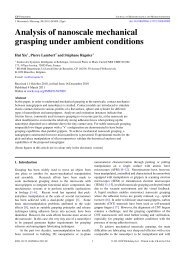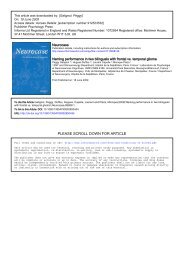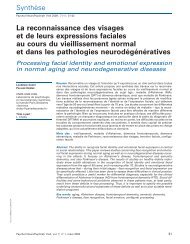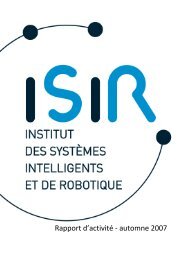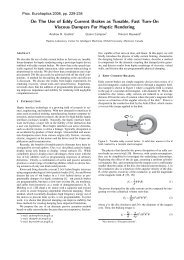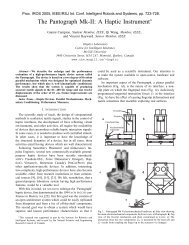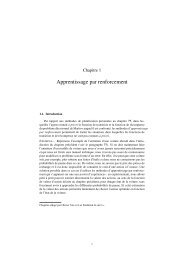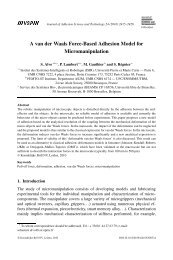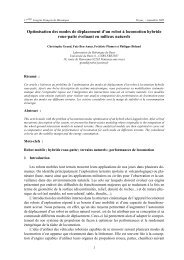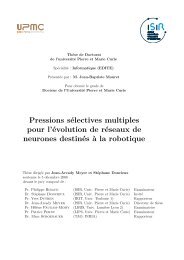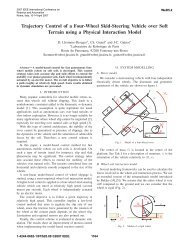Nonlinear Attitude and Position Control of a Micro Quadrotor using ...
Nonlinear Attitude and Position Control of a Micro Quadrotor using ...
Nonlinear Attitude and Position Control of a Micro Quadrotor using ...
You also want an ePaper? Increase the reach of your titles
YUMPU automatically turns print PDFs into web optimized ePapers that Google loves.
3rd US-European Competition <strong>and</strong> Workshop on <strong>Micro</strong> Air Vehicle Systems (MAV07) & European <strong>Micro</strong> Air VehicleConference <strong>and</strong> Flight Competition (EMAV2007), 17-21 September 2007, Toulouse, France<strong>Nonlinear</strong> <strong>Attitude</strong> <strong>and</strong> <strong>Position</strong> <strong>Control</strong> <strong>of</strong> a <strong>Micro</strong><strong>Quadrotor</strong> <strong>using</strong> Sliding Mode <strong>and</strong> BacksteppingTechniquesPatrick Adigbli ∗Technische Universität München, 80290 München, Germany <strong>and</strong>Christophe Gr<strong>and</strong> † <strong>and</strong> Jean-Baptiste Mouret ‡ <strong>and</strong> Stéphane Doncieux §ISIR, Institut des Systèmes Intelligents et Robotique, 75016 Paris, FranceThe present study addresses the issues concerning the developpment <strong>of</strong> a reliable assistedremote control for a four-rotor miniature aerial robot (known as quadrotor), guaranteeingthe capability <strong>of</strong> a stable autonomous flight. The following results are proposed: afterestablishing a dynamical flight model as well as models for the rotors, gears <strong>and</strong> motors<strong>of</strong> the quadrotor, different nonlinear control laws are investigated for attitude <strong>and</strong> positioncontrol <strong>of</strong> the UAV. The stability <strong>and</strong> performance <strong>of</strong> feedback, backstepping <strong>and</strong>sliding mode controllers are compared in simulations. Finally, experiments on a newlyimplemented quadrotor prototype have been conducted in order to validate the theoreticalanalysis.I. IntroductionAs their application potential both in the military <strong>and</strong> industrial sector strongly increases, miniatureunmanned aerial vehicles (UAV) constantly gain in interest among the research community. Mostlyused for surveillance <strong>and</strong> inspection roles, building exploration or missions in unaccessible or dangerousenvironments, the easy h<strong>and</strong>ling <strong>of</strong> the UAV by an operator without hours <strong>of</strong> training is primordial. In orderto develop a reliable assisted remote control or guarantee the capability <strong>of</strong> a stable autonomous flight, thedevelopment <strong>of</strong> simple <strong>and</strong> robust control laws stabilizing the UAV becomes more <strong>and</strong> more important.This article addresses the design <strong>and</strong> analysis <strong>of</strong> nonlinear attitude <strong>and</strong> position controllers for a four-rotoraerial robot, better known as quadrotor. This aircraft has been chosen for its specific characteristics suchas the possibility <strong>of</strong> vertical take <strong>of</strong>f <strong>and</strong> l<strong>and</strong>ing (VTOL), stationary <strong>and</strong> quasi-stationary flight <strong>and</strong> highmanoeuverability. Moreover, its simple mechanical structure compared to a helicopter with variable pitchangle rotors <strong>and</strong> its highly nonlinear, coupled <strong>and</strong> underactuated dynamics make it an interesting researchplatform.The present article proposes the following results: in the second part, models for the propulsion system<strong>and</strong> the flight dynamic <strong>of</strong> the UAV are proposed. In the third part, different nonlinear control laws tostabilize the attitude <strong>of</strong> the quadrocopter are investigated. In the fourth part, a new position controller forautonomous waypoint tracking is designed, <strong>using</strong> the backstepping approach. Finally, the performance <strong>of</strong>the investigated controllers are compared in simulations <strong>and</strong> experiments on a real system. For that purpose,a prototype <strong>of</strong> the quadrocopter has been implemented.II. Modelling the electromechanical systemIn this section, a complete model <strong>of</strong> the quadrocopter system is established. First, a model <strong>of</strong> thepropulsion system represented in Fig.1 is proposed, deriving theoretical linear <strong>and</strong> nonlinear models for therotor, gear <strong>and</strong> motor.∗ Master student TUM/ECP, Institute <strong>of</strong> Automatic <strong>Control</strong> Engineering, patrick.adigbli@centraliens.net† Pr<strong>of</strong>. assistant, dept SIMA, gr<strong>and</strong>@robot.juiisu.fr‡ PhD student, dept SIMA, Jean-Baptiste.Mouret@lip6.fr§ Pr<strong>of</strong>. assistant, dept SIMA, Stephane.Doncieux@upmc.fr1
3rd US-European Competition <strong>and</strong> Workshop on <strong>Micro</strong> Air Vehicle Systems (MAV07) & European <strong>Micro</strong> Air VehicleConference <strong>and</strong> Flight Competition (EMAV2007), 17-21 September 2007, Toulouse, FranceThe reactive torque τ R caused by the drag <strong>of</strong> the rotor blade<strong>and</strong> the thrust f are proportional to the square <strong>of</strong> the rotationalvelocity ω <strong>of</strong> the rotor (see McKerrow et al. 1 ):f = k l ω 2 , τ R = k d ω 2 (1)The gear is located between the rotor <strong>and</strong> the couplegeneratingmotor a , in order to transmit the mechanical powerwhile changing the motor couple τ M <strong>and</strong> the rotational velocityω. Considering the mechanical losses by introducing theefficiency factor η G , the gear reduction ratio G as well as thetotal torque <strong>of</strong> inertia ˜J tot on the motor side can be calculated:Figure 1. Propulsion system.G = ˜ω ω = τ M˜τ M1η G<strong>and</strong> ˜Jtot = J RG 2 + J M (2)The well-known electromechanical model <strong>of</strong> the dc motor is described by the two following equations,introducing the back-EMF constant k emk <strong>and</strong> the torsional constant k M :L M ˙i M = ū M − R M i M − k emk ω (3)˜J tot ˙˜ω = ˜τ M − ˜τ R = k M i M − ˜τ R (4)With respect to the fact that the motor inductivity L M can be considered small in comparison to the motorresistance R M , the system dynamic can be reduced. By taking into account the equations (1) <strong>and</strong> (2), thesimplified nonlinear model for the propulsion system is:˙ω =k MR M G ˜Jū M − k M k emk k dtot R M G ˜Jω − ω 2 (5)tot G 2 η G ˜JtotThe stationary response curve can be linearized around the operating point (ω ∗ ,ū ∗ M ), finally leading to thesimplified <strong>and</strong> linearized propulsion system model used in this article b :ω = K 1T s + 1 ūM + K 2T s + 1This model has been verified by an experimental analysison the propulsion system, <strong>using</strong> the Least-Square-Fittingmethod.(6)After proposing the model <strong>of</strong> the electromechanical propulsionsystem, a simplified quasi-stationary flight dynamic modelbased on the work <strong>of</strong> Lozano et al. 2 <strong>and</strong> Bouabdallah <strong>and</strong>al. 3 will be established. Considering the whole quadrotorsystem represented in Fig.2, the earth-fixed coordinate systemS W = [X,Y ,Z] T <strong>and</strong> the body-fixed coordinate systemS uav = [x,y,z] T are introduced. The position ξ = [x,y,z] T <strong>of</strong>the UAV is given by the position <strong>of</strong> the origin <strong>of</strong> the body-fixedcoordinate system relativ to the origin <strong>of</strong> the earth coordinateFigure 2. Representation <strong>of</strong> the quadrotor system,introducing torques, forces <strong>and</strong> coordinatesystems.system. The orientation <strong>of</strong> the UAV in space is described by the Tait-Bryan-angles η = [Φ,Θ,Ψ] T <strong>and</strong> therotation matrix R c :a All variables on the motor side are marked with a tilde, while all variables on the rotor side aren’t marked.b With the parameters:η G G k Mk d ω ∗2 R Mη G G 2 K 1 =2 k d ω ∗ , K 2 =R M + η G G k emk k M 2 k d ω ∗ , T =˜J tot R MR M + η G G k emk k M 2 k d ω ∗ R M + η G G k emk k Mc In this article, the representation <strong>of</strong> the rotation matrix R is based on the following rotation order: the first rotation withthe angle Φ around the x-axis, the second rotation with the angle Θ around the new y-axis <strong>and</strong> the third rotation with theangle Ψ around the new z-axis.2
3rd US-European Competition <strong>and</strong> Workshop on <strong>Micro</strong> Air Vehicle Systems (MAV07) & European <strong>Micro</strong> Air VehicleConference <strong>and</strong> Flight Competition (EMAV2007), 17-21 September 2007, Toulouse, France⎛⎞c Θ c Ψ s Φ s Θ c Ψ − c Φ s Ψ c Φ s Θ c Ψ + s Φ s Ψ⎜⎟R = ⎝c Θ s Ψ s Φ s Θ s Ψ + c Φ c Ψ c Φ s Θ s Ψ − s Φ c Ψ ⎠ (7)−s Θ s Φ c Θ c Φ c ΘThe angular rotation velocities Ω in the body-fixed coordinates can be obtained with respect to theangular rotation velocities ˙η in the earth-fixed coordinates:⎛ ⎞1 0 −s Θ⎜ ⎟Ω = ⎝0 c Φ s Φ c Θ ⎠ ˙η = W(η) ˙η (8)0 −s Φ c Φ c ΘNow, a full dynamical model <strong>of</strong> the position <strong>and</strong> angular acceleration <strong>of</strong> the quadrocopter is derived,showing that the Euler-Lagrange-formalism, which is also used in the work <strong>of</strong> Lozano et al., 2 leads tothe same results as the Newton-Euler approach used by Bouabdallah et al. 3 Introducing ρ = [ξ,η] T <strong>and</strong>applying the Hamilton principle to the Lagrange function L(ρ, ˙ρ) = T (ρ, ˙ρ) − V(ρ) composed <strong>of</strong> the kinetic<strong>and</strong> potential energies T <strong>and</strong> V <strong>of</strong> the global mechanical system leads to the Euler-Lagrange-equations:ddt( ∂L∂ ˙ρ i)− ∂L∂ρ i= Q i with i = 1...6 (9)First, all components <strong>of</strong> the Lagrange function L <strong>and</strong> the generalized potential-free force vector Q have tobe identified. Both can be divided in a translational <strong>and</strong> a rotational part:L trans = T trans − V = 1 2 m ˙ξ)Tuav ˙ξ + muav g z Q trans = R−FL rot = T rot = 1 2 ΩT I Ω = 1 ( )0 l kl 0 −l k l2 ˙ηT J ˙η Q rot = τ + τ gyro = l k l 0 −l k l 0 ω 2k d −k d k d −k d4∑+ J R (Ω × e z )(−1) i+1 ω iNow, the Euler-Lagrange-equations for position <strong>and</strong> orientation can be deduced independently:( )(Q trans = d ∂L transdt ∂ ˙ξ − ∂Ltrans∂ξ¨ξ = Q 00g)trans( )mQ rot = d ∂Lrot⇔uav ( +dt ∂ ˙η− ∂Lrot∂η¨η = J −1 (Q rot + 1 ∂2 ∂η ˙η T J ˙η ) − ˙J(10)˙η)After considering the hypothesis <strong>of</strong> small angles <strong>and</strong> small angular velocities, the full dynamical model(10) can be simplified, resulting in a nonlinear coupled model containing terms for the coriolis forces <strong>and</strong>gyroscopic torques:Fẍ = −m uav(c Φ c Ψ s Θ + s Φ s Ψ )ÿ = −Fm uav(c Φ s Ψ s Θ − s Φ c Ψ )¨z = −F (c Φ c Θ ) + gm uav¨Φ = τΦI x− JR ΠI x¨Θ = τΘI y+ JR ΠI y¨Ψ = τΨI z+˙Φ ˙ΘIII. <strong>Attitude</strong> stabilization( 00i=1˙Θ + ˙Θ ˙Ψ˙Φ + ˙Φ ˙Ψ( )Ix−I yI z( )Iy−I zI x( )I z−I xI yIn a next step, different nonlinear control laws for the control torque vector τ ctrl = [τ ctrlΦ,τctrlΘ(11),τctrlΨ ]Tare investigated in order to stabilize the highly nonlinear, underactuated system, even in presence <strong>of</strong> perturbations.The control architecture represented in Fig.3 remains the same for the different control laws.3
3rd US-European Competition <strong>and</strong> Workshop on <strong>Micro</strong> Air Vehicle Systems (MAV07) & European <strong>Micro</strong> Air VehicleConference <strong>and</strong> Flight Competition (EMAV2007), 17-21 September 2007, Toulouse, FranceIn order to formally prove the stability <strong>of</strong> this sliding mode controller, the following two assumptionshave to be verified:1. The system has to reach the sliding manifolds S i after a finite time, independently from the systemsinitial state x 0 .2. The motion along the sliding manifolds S i must have a stable behaviour.In order to verify the second assumption, Utkins equivalent control method will be used: 6 therefore, acontinuous equivalent control variable u eq must exist <strong>and</strong> verify the condition:min (u) ≤ u eq ≤ max (u) (16)In the sliding mode, u eq replaces u <strong>and</strong> with (14), we have ṡ(x) = 0 <strong>and</strong> ṡ(x) = ∂s∂x ẋ = ∂s∂x (f (x) + B u eq).Consequently, the equivalent control is given by:∂s∂x( ) −1 ( ∂su eq = −∂x B ∂s∂x f (x) with ∂s c4/I∂x B = x 0 00 c 5/I y 00 0 c 6/I z)The existence <strong>of</strong> u eq is guaranteed, because the inverse <strong>of</strong> ∂s∂xB exists <strong>and</strong> the components <strong>of</strong> the termf (x) could become zero only in single isolated points <strong>of</strong> the state space. Thus, the second assumptionis partially verified, only (16) has to be satisfied. To guarantee this, we consider assumption 1, which isequivalent to finding the so called domain <strong>of</strong> sliding mode <strong>and</strong> can be reduced to a stability problem withthe state vector s <strong>and</strong> the lyapunov function V (s) = sign(s) T s. Considering (14), (17) <strong>and</strong> (15), thederivative <strong>of</strong> V is:˙V (s) = −K sign(s) T ∂s∂sB sign(s) − sign(s)T∂x ∂x B u eqBecause ∂s∂x B is positive definite, {the first }term <strong>of</strong> ˙V is confined{to c min ‖sign(s)‖}2 ≤ sign(s) T ∂s∂x B sign(s) ≤c max ‖sign(s)‖ 2 cwith c min = min 4I x, c5I y, c6cI z<strong>and</strong> c max = max 4I x, c5I y, c6I z<strong>and</strong> we have:˙V (s) ≤ −Kc min ‖sign(s)‖ 2 + ‖sign(s) T ‖ ‖ ∂s∂x B‖ ‖u eq‖Outside <strong>of</strong> the sliding manifolds S i , we have ‖sign(s)‖ ≥ 1, because at least one component s i ≠ 0.Therefore, the derivative <strong>of</strong> the lyapunov function is negative, when we have:(17)K > ‖ ∂s∂x B‖ ‖u eq‖c min(18)By choosing K according to (18), the domain <strong>of</strong> sliding mode corresponds to the whole state space,verifying assumption 1. Furthermore, we will now show that (16) ⇔ −K ≤ u eq ≤ +K ⇒ ‖u eq ‖ ≤ K( ) 2 ( ) 2 ( )is satisfied by this choice <strong>of</strong> K. Considering the Frobeniusnorm ‖ ∂s∂x B‖2 F = c 4I x+c 5I y+c 2,6I zthestability <strong>of</strong> the sliding mode controller is formally proven, because we have:‖u eq ‖ < Kc min‖ ∂s∂x B‖ F≤ K (19)IV.<strong>Position</strong> controlAnother main contribution <strong>of</strong> the present article is the design <strong>of</strong> a position controller based on thebackstepping approach. The superposition <strong>of</strong> the position controller over the attitude controller in a cascadearchitecture (shown in Fig.4) enables the robot to perform autonomous waypoint tracking: the operatoror path planner provides the desired values x d ,y d ,z d <strong>and</strong> Ψ d <strong>and</strong> the position controller calculates thecorresponding control values Φ ctrl ,Θ ctrl <strong>and</strong> F ctrl , which represent the set values <strong>of</strong> the underlying attitude5
3rd US-European Competition <strong>and</strong> Workshop on <strong>Micro</strong> Air Vehicle Systems (MAV07) & European <strong>Micro</strong> Air VehicleConference <strong>and</strong> Flight Competition (EMAV2007), 17-21 September 2007, Toulouse, Francecontroller. To derive the backstepping position control law, a diffeomorphism transforms the position vectorξ = [x,y,z] T into z-coordinates. This operation will be illustrated <strong>using</strong> the x-coordinate:z 1 = x − x d , z 2 = ẋ − ẋ d − β 1 (z 1 ),z˙1 = ẋ − ẋ d = z 2 + β 1 (z 1 )By introducing the ( partial lyapunov ) functionsV 1 = 1 2 z2 1 <strong>and</strong> V 2 = 1 2 z21 + z22 , it is possible todetermine the function β 1 (z 1 ) <strong>and</strong> two parametersb 1 ,b 2 > 0 such that the derivate V ˙ 2 ≡ − ∑ 2i=1 b izi 2
3rd US-European Competition <strong>and</strong> Workshop on <strong>Micro</strong> Air Vehicle Systems (MAV07) & European <strong>Micro</strong> Air VehicleConference <strong>and</strong> Flight Competition (EMAV2007), 17-21 September 2007, Toulouse, FranceΦ, Θ, Ψ [deg]403020100-10-20-30-40-50Feedback controller, anglesΦΘΨ0 0.5 1 1.5 2 2.5 3 3.5 4Time [s]Φ, Θ, Ψ [deg]403020100-10-20-30-40-50Backstepping controller, anglesΦΘΨ0 0.5 1 1.5 2 2.5 3 3.5 4Time [s]Φ, Θ, Ψ [deg]403020100-10-20-30-40-50Sliding mode controller, anglesΦΘΨ0 0.5 1 1.5 2 2.5 3 3.5 4Time [s][Nm]τ Φctrl , τΘctrl , τΨctrl0.40.30.20.10-0.1-0.2-0.3Feedback controller, control torquesτ Φctrlτ Θctrlτ Ψctrl-0.40 0.5 1 1.5 2 2.5 3 3.5 4Time [s][Nm]τ Φctrl , τΘctrl , τΨctrl0.40.30.20.10-0.1-0.2-0.3Backstepping control, control torquesτ Φctrlτ Θctrlτ Ψctrl-0.40 0.5 1 1.5 2 2.5 3 3.5 4Time [s][Nm]τ Φctrl , τΘctrl , τΨctrlSliding mode controller, control torques0.4ctrlτ0.3Φctrlτ Θctrl0.2τ Ψ0.10-0.1-0.2-0.3-0.40 0.5 1 1.5 2 2.5 3 3.5 4Time [s]Figure 5. Simulation results <strong>of</strong> the attitude stabilisation, η d = [0 ◦ , 0 ◦ , 0 ◦ ] T . Top row: angles with feedback control (left),backstepping control (middle), sliding mode control (right). Bottom row: control torques with feedback control (left),backstepping control (middle), sliding mode control (right). <strong>Control</strong>ler parameters: µ x = µ y = µ z = 0.4, µ q = 10, a 1 =a 2 = a 4 = a 6 = 7, a 3 = 2, a 5 = 5, K = 0.04, c 1 = c 3 = c 5 = 1, c 2 = 0.3, c 4 = 0.5, c 6 = 0.440Feedback controller, angles40Backstepping controller, angles40Sliding mode controller, angles202020Φ, Θ, Ψ [deg]0-20ΦΘΨΦ, Θ, Ψ [deg]0-20ΦΘΨΦ, Θ, Ψ [deg]0-20ΦΘΨ-40-40-40-600 2 4 6 8 10Time [s]-600 2 4 6 8 10Time [s]-600 2 4 6 8 10Time [s][Nm]τ Φctrl , τΘctrl , τΨctrl0.40.30.20.10-0.1-0.2-0.3Feedback controller, control torquesτ Φctrlτ Θctrlτ Ψctrl-0.40 2 4 6 8 10Time [s][Nm]τ Φctrl , τΘctrl , τΨctrlBackstepping controller, control torques0.4ctrlτ0.3Φctrlτ Θctrl0.2τ Ψ0.10-0.1-0.2-0.3-0.40 0.5 1 1.5 2 2.5 3 3.5 4Time [s][Nm]τ Φctrl , τΘctrl , τΨctrlSliding mode controller, control torques0.4ctrlτ0.3Φctrlτ Θctrl0.2τ Ψ0.10-0.1-0.2-0.3-0.40 0.5 1 1.5 2 2.5 3 3.5 4Time [s]Figure 6. Simulation results <strong>of</strong> the setpoint tracking, η d = [30 ◦ , 20 ◦ , −45 ◦ ] T . Top row: angles with feedback control(left), backstepping control (middle), sliding mode control (right). Bottom row: control torques with feedback control(left), backstepping control (middle), sliding mode controller (right). <strong>Control</strong>ler parameters: µ x = µ y = µ z = 0.7, µ q =5, a 1 = a 3 = a 5 = 4, a 2 = a 4 = a 6 = 3, K = 0.03, c 1 = c 3 = c 5 = 1, b 2 = 0.4, b 4 = b 6 = 0.5For the validation <strong>of</strong> the position controller, various scenarios have been simulated, showing promissingresults for an implementation on the real system. For example, the UAV has to follow a helix formedpath while rotating around his own z-axis: the simulation result is represented in Fig.7, showing the stabletracking behaviour <strong>of</strong> the complete closed loop system.Moreover, a low cost autonomous miniature drone (represented in Fig.8) has been designed <strong>and</strong> implemented,<strong>using</strong> exclusively <strong>of</strong>f-the-shelf components <strong>and</strong> open source s<strong>of</strong>tware: employing a highly integratedembedded inertial measurement unit discussed in the work <strong>of</strong> Jang et al. 9 <strong>and</strong> the power <strong>of</strong> a real timeonboard CPU, the backstepping control law has been implemented on the real system suspended on a tripod.Fig.9 shows some first test results obtained with the prototype, which is stabilized around η = 0.Improvements have still to be made on the hardware to enhance the controller dynamics, particularly withregard to the closed-loop speed control <strong>of</strong> the motors.7
3rd US-European Competition <strong>and</strong> Workshop on <strong>Micro</strong> Air Vehicle Systems (MAV07) & European <strong>Micro</strong> Air VehicleConference <strong>and</strong> Flight Competition (EMAV2007), 17-21 September 2007, Toulouse, FranceDesired <strong>and</strong> real trajectories (in meters)zDesired trajectory-7Real trajectory-6-5-4-3-2-1-2 0 -1.5 -1-0.50 0.50 0.5 1 1.5 2x 1 y1.5 2 -2-1.5-1-0.5 Desired <strong>and</strong> real trajectories (in meters)zDesired trajectory-7Real trajectory-6-5-4-3-2-1-1 00 1 2 3 4 5 6 -1 0 1 2 3 4 5 6xyx, y, z [m]x, y, z [m]1050-5<strong>Position</strong> over timexyz-100 10 20 30 40 50 60 70Time [s]1050-5<strong>Position</strong> over timexyz-100 10 20 30 40 50 60 70Time [s]Φ, Θ [deg]403020100-10-20-30Angles over timeΦΘ-400 10 20 30 40 50 60 70Time [s]Figure 7. Simulation results <strong>of</strong> the position controller. Top row: the UAV tracks well the desired path in form <strong>of</strong> a helix(left), it’s actual position ξ is plotted (middle) <strong>and</strong> a 3D-animation (right) visualizes the simulation results. Bottom row:the UAV tracks well the desired quadratic path (left), it’s actual position ξ is plotted (middle) <strong>and</strong> the angular values Φ, Θare plotted (right). <strong>Attitude</strong> controller parameters: a 1 = a 2 = a 3 = a 4 = a 5 = a 6 = 7, b 1 = b 2 = 5, b 3 = b 5 = 1, b 4 = b 6 = 2Φ, Θ [deg]3020100-10-20AnglesΦΘτ ctrl [Nm]0.10.050-0.05<strong>Control</strong> torques (backstepping)τ Φ3020100-10τΘ-30Ω [deg/s]-20Angular velocity (from sensors)Ω xΩ y-30-0.10 2 4 6 8 10 120 2 4 6 8 10 120 2 4 6 8 10 12Time [s]Time [s]Time [s]Figure 9. First test results <strong>of</strong> the backstepping attitude controller.VI. ConclusionIn this article, a complete <strong>and</strong> a simplified model for a fourrotorflying robot have been proposed. Moreover, three differentcontrol approaches have been investigated <strong>and</strong> discussed: afeedback control law, a backstepping control law <strong>and</strong> a newlyestablished sliding mode control law. The performances havebeen analysed <strong>using</strong> various simulation results, showing therobust behaviour <strong>of</strong> the backstepping <strong>and</strong> sliding mode controllersregarding the stabilization <strong>and</strong> the setpoint tracking<strong>of</strong> the complete UAV model, whereas the feedback controllershows poor performance regarding the setpoint tracking. Furthermore,a new position controller has been proposed, permittingan autonomous waypoint tracking <strong>and</strong> showing promissingsimulation results. Finally, a low cost prototype has been implemented,showing promissing first test results.Figure 8. Quadrocopter prototype with anhighly integrated Inertial Measurment Unit <strong>and</strong>a ARM-based CPU running a linux OS.References1 McKerrow, P., “Modelling the Draganflyer four-rotor helicopter,” IEEE International Conference on Robotics <strong>and</strong> Automation,2004, 2004, pp. 3596– 3601.2 Escareno, J., Salazar-Cruz, S., <strong>and</strong> Lozano, R., “Embedded control <strong>of</strong> a four-rotor UAV,” Proceedings <strong>of</strong> the 2006 American<strong>Control</strong> Conference Minneapolis, 2006, 2005.3 Bouabdallah, S. <strong>and</strong> Siegwart, R., “Backstepping <strong>and</strong> Sliding-mode Techniques Applied to an Indoor <strong>Micro</strong> <strong>Quadrotor</strong>,”IEEE International Conference on Robotics <strong>and</strong> Automation, 2005, 2005, pp. 2247– 2252.8
3rd US-European Competition <strong>and</strong> Workshop on <strong>Micro</strong> Air Vehicle Systems (MAV07) & European <strong>Micro</strong> Air VehicleConference <strong>and</strong> Flight Competition (EMAV2007), 17-21 September 2007, Toulouse, France4 Tayebi, A. <strong>and</strong> McGilvray, S., “<strong>Attitude</strong> Stabilization <strong>of</strong> a VTOL <strong>Quadrotor</strong> Aircraft,” IEEE Transactions on controlsystems technology, 2006, Vol. 14, 2006, pp. 562– 571.5 Wendel, J. <strong>and</strong> Bruskowski, L., “Comparison <strong>of</strong> Different <strong>Control</strong> Laws for the Stabilization <strong>of</strong> a VTOL UAV,” European<strong>Micro</strong> Air Vehicle Conference <strong>and</strong> Flight Competition 2006 25 - 26.07.2006, Braunschweig, 2006.6 Utkin, V. I., “Variable structure systems with sliding modes,” IEEE Transactions on Automatic <strong>Control</strong>, Vol. AC-22,1977, pp. 212–222.7 Kondak, K., Hommel, G., Stanczyk, B., <strong>and</strong> Buss, M., “Robust Motion <strong>Control</strong> for Robotic Systems Using Sliding Mode,”Proceedings <strong>of</strong> the IEEE/RSJ International Conference on Intelligent Robots <strong>and</strong> Systems, 2005, 2005, pp. 2375 – 2380.8 Br<strong>and</strong>tstadter, H. <strong>and</strong> Buss, M., “<strong>Control</strong> <strong>of</strong> Electromechanical Systems <strong>using</strong> Sliding Mode Techniques,” 44th IEEEConference on Decision <strong>and</strong> <strong>Control</strong>, 2005 <strong>and</strong> 2005 European <strong>Control</strong> Conference, 2005, pp. 1947 – 1952.9 Jang, J. <strong>and</strong> Liccardo, D., “Automation <strong>of</strong> small UAVs <strong>using</strong> a low cost MEMS sensor <strong>and</strong> embedded computing platform,”25th Digital Avionics Systems Conference, 2006, 2006.9



